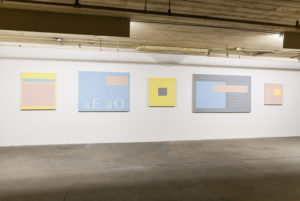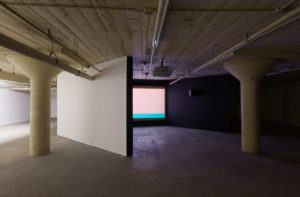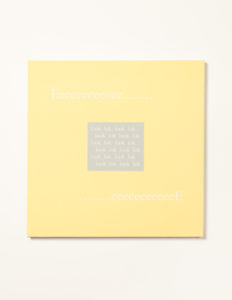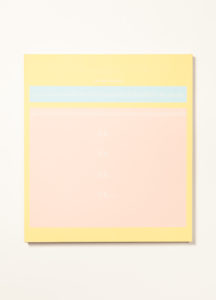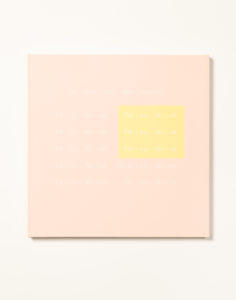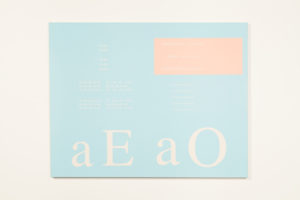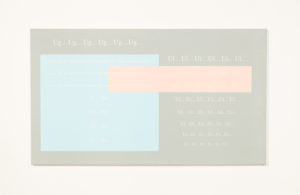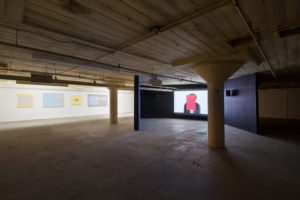Ben Vida: Slipping Control (West)
- Ben Vida interviewed by Ethan Swan, March 2015
conducted on the occasion of Ben Vida’s solo exhibition at 356 Mission
Ethan Swan: Do you want to start by telling me about how this presentation differs from the previous versions?
Ben Vida: I’ve been living with this project for a few years now and have done enough versions of it that I find it is starting to fold back on itself, and this is causing some interesting ruptures. In past shows I have coupled the video with prints and with objects but the inclusion of the five paintings for the 356 show was a step towards stretching the role of the text beyond its original purpose.
ES: These paintings that are introduced in this iteration gave you the opportunity to introduce color to the score of the piece. You’ve made this score available in the past, but only in black and white. Can you talk about how you decided on the colors and what effect that’s had for you?
BV: Since the underlying concept of the Slipping Control project is the mapping of the control paths (that is, the order of decisions that are made throughout the production of a piece) and that all of the pieces in this project begin from a shared starting point or input (the text), the palette that I am using for the paintings was directly informed by earlier works. This control paths logic applies not only to the internal workings of individual pieces but also across the whole body of work, so earlier iterations now act to inform the control paths of newer pieces.
some examples of control paths:
Text -> Vocalist -> Voiced Recording -> Electronic Analysis -> Reconfigured Text- > Audio Synthesis -> LP Record.
Text -> Vocalist -> Video/Audio Recording -> Electronic Analysis -> Reconfigured Text-> Audio Synthesis -> Video Editing -> Color Synthesis -> Video Installation.
So for instance, the decision making process or control path that directed the production of the new paintings were informed not only by the original text but also by the decision making that went into creating the video. The video becomes a step in the paintings control path.
Text -> Vocalist -> Video/Audio Recording -> Electronic Analysis -> Reconfigured Text-> Audio Synthesis -> Video Editing -> Color Synthesis -> Video Installation-> Color Field and Text Painting.
In the video I play with the idea of forced synesthesia. I like thinking of synesthesia as being a slippage between the senses. I like the idea that our senses use to be less delineated from one another – that maybe we had in an earlier evolutionary moment a better way of sensing across sight and sound and taste. So what happens when you hear an abstract sound coupled with the image of a vocalist, but then you have that same sound with just a color field? How does your relationship to sensing that sound or that color change? Do they clarify or distort one another when put into proximity of one another? In the paintings I wanted the color to act to either foreground or obscure the text depending on the different contrast levels and color relationships.
ES: What’s interesting in terms of this relationship in terms of sound and vision and these different senses is that artists who identify as synesthetic have a tendency to go towards blurry or burst-y images. Like a Kandinsky painting. It’s very active and energetic in this way as opposed to the pure tone that you’re working with. The use of color isn’t controlled, per se, but it has a much stricter quality in your work.
BV:I think it’s not gestural. It’s a blunt tool.
ES: You’re not mimicking an experience, you’re trying to create it.
BV: Exactly. Well, maybe it’s a suggested synethesia.
ES: How literal is the score? Could a person stand in front of one of the paintings and follow along with the video?
BV: Perhaps not that easily, but there are moments when a painting will sync up with the audio from the video. Originally, the score was made available as a publication, a book of poems that included a download code for a bunch of audio tracks. The poems could be used as a kind of lyrics sheet so you could follow along on the pages that corresponded to each track. The process of turning the poems into data that then could be sonified abstracted their original forms right from the start so when the text is read along with the audio a kind of creative syncing between the listener and the materials occurs.
ES: In terms of that information, can you talk about how you first put those sounds together?
BV: It started with characters on the page. I wanted to create very rhythmic, controlled content for the synthesizer but I wanted it to always be failing. I wanted there to be the possibility of losing a beat, or rushing, or dragging. Things that don’t happen in machine logic as automatically. It’s very gridcentric, the machine mind. Knowing that I wouldn’t be the main interpreter of the text, I didn’t want to voice it first and then type it out, instead I wanted to create something on the page that would encourage the kind of performance I was hoping to get from the vocalists, but without having to give too many instructions. If it looked rhythmic on the page, if it looked like four on the floor, I just trusted it. After working on it for a week, I started to voice it for the first time and I was so surprised at how physical and demanding it was. That was something I wasn’t expecting I’d be asking of the performers I was handing it to, but I was glad to have created something that wasn’t purely rudimentary. I was glad to have composed something that had room for a richer and more personalized virtuosic engagement.
ES: With the installation, we spent a lot of time making sure that you could take in the paintings and the video at the same time. Obviously they each reward closer examination on their own but I’m interested in how important it was that they were visible in parallel.
BV: I really like this idea of proximity and what resonates when you get certain objects together or the tempo of reveal when you get pieces that are related in a way that’s not immediately obvious. The challenge of working with the 356 space was all about having enough darkness for the projection and having enough light for the paintings, having them all be able to be seen from one point, and having the sound from the video audible while you’re looking at the paintings so perhaps you would be lead back over to the video with the information that you’ve gleaned from them.
ES: In the same way that it’s important for the viewer to be able to see the objects and the video at the same time, one of the things that you and I had discussed when the paintings were finished was the idea that it’s helpful to have more than one. As the similarities and differences unfold between the individual works, there’s a sense that they together teach you the language. It’s not opaque by any means but it’s not usual, the characters as they appear in the works. It’s different then words written on a page so how do I read it? Do I read it?
BV: I like the idea that, given a little time this work begins to reveal its methodologies to the viewer. That there is a simple system at play that can be decoded and figuring that out opens up subtler aspect of the work. I think that if people are engaged by what they see and hear they will take the time to receive the work on a deeper level. No matter how abstract the system might be I still want the work to be generous. I don’t want to assume that a certain kind of listener/viewer won’t be able to receive it. I’m not interested in closing anyone out of the experience. It’s too cocky or something. It doesn’t make any sense. If there is one thing that this works asks it is to just take it a little slower.
ES: In the context of what we’re talking about, I want to ask about two moments in the video that stand out for me. There’s one moment where Ty starts to vocalize and then pauses, coughs, and goes back to the beginning of the phrase. Later there’s another moment where Sara laughs. Do those moments have a relationship with what we’re talking about? Or is there another reason for that?
BV: Those moments were really deliberate. They’re moments that should’ve been clipped. In the case of Sara’s laughing, that’s my way of communicating the person of Sara so clearly. Because anyone who knows her knows she’s an amazing person and someone who radiates a certain type of kindness. I didn’t want to clip every moment of her and only have her functioning as a robot, you know what I mean? It’s Sara, and that it’s Sara and not another performer is what matters. So it’s a moment of reveal. With Ty and that coughing, there’s no sound during that, so for me that’s a moment of preparation that’s not scored material and so it’s not sonified material. When the sound comes in that is the beginning of the score. A little hint.
Ethan Swan is a director of 356 Mission
-
Katy Fischer and Ben Vida opening receptions
March 18, 2015

